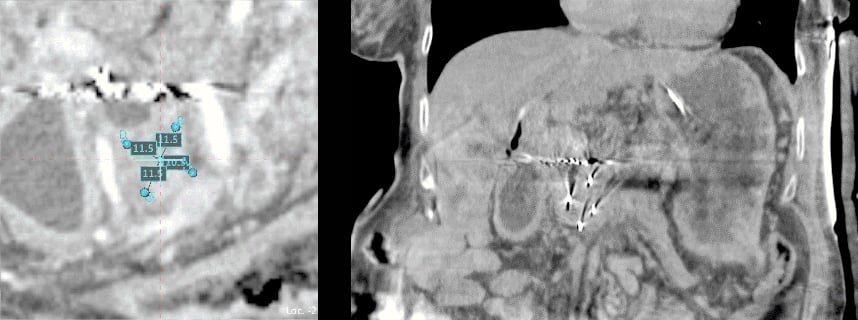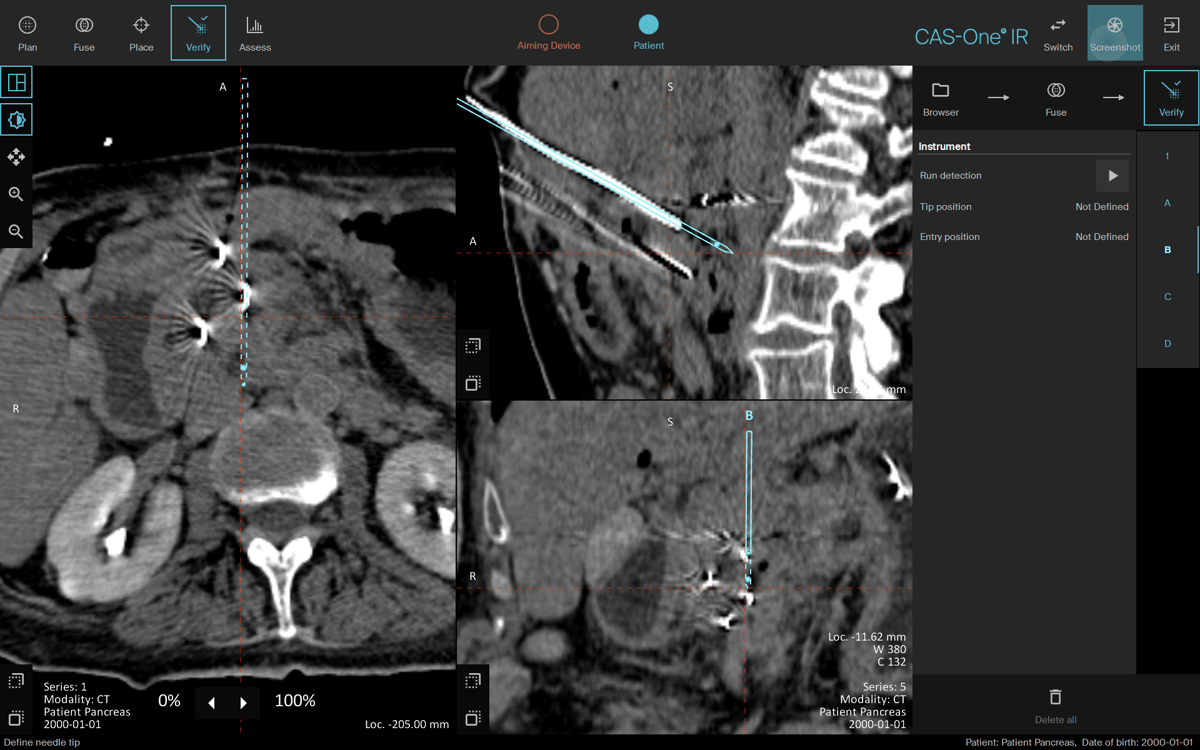Trans-Hepatic approach to a Pancreas head carcinoma with IRE
One of the most complex CAS-One IR cases to date - a trans-hepatic approach to a pancreas head tumor treated with irreversible electroporation (IRE). This 67 year-old female with a 41 mm. lesion in the pancreas head, was not willing to undergo another resection surgery. She was treated with this minimal invasive approach. The planning capabilities of CAS-One IR were critical as the four needles had to be placed in close proximity to two main arteries and the mesenterico-portal vein, and of course, as parallel as possible. The case was quick (< 3 hours) and successful as the post-procedure MRI showed complete destruction of the tumor.
Video of the four-needle intra-hepatic trajectory

Left: Needle eye view of the planning in between the SMA, an additional right hepatic artery originating from the SMA and the SMV and portal vein. Right: highly accurate needle positioning after placement.
 Needle confirmation with all four needles accurately placed, paralleled, and spaced
Needle confirmation with all four needles accurately placed, paralleled, and spaced
 Three Day Post-IRE MRI images showcasing the destruction of the lesion
Three Day Post-IRE MRI images showcasing the destruction of the lesion
Name: Prof. Dr. Thiery Chapelle & Dr. Bart Op de Beeck
Institution: Antwerp University Hospital, Antwerp, Belgium
Patient age and sex: 67 years, female
Initial condition:
- The patient was diagnosed with Morbus Crohn and underwent several abdominal procedures over time:
- Abdominal Hysterectomy
- Angioplasty of coronaries
- Cholecystectomy, with a complication resulting in a hepatic-enterostomy
- Surgical repair (abdominal hernia), complicated by an intestinal perforation
- At the beginning of 2022, a locally advanced pancreas-head carcinoma was diagnosed with a diameter of 41 mm and encasement of the Arteria Mesenterica Superior (posterior side) - T4N0M0
- Part of the treatment was with neoadjuvant chemotherapy - 4x Folfirinox with partial response.
- Unfortunately, she developed after completing neo-adjuvant chemotherapy severe malnutrition with need for total parenteral nutrition and was admitted several times for respiratory failure
- The patient refused Whipple surgery, further chemotherapy or radiation.
- An Irreversible Electroporation (IRE) with the guidance of CAS-One IR was proposed as treatment modality and approved by the patient
- A gastric outlet syndrome developed just before the planned treatment and was treated after the IRE with a LAMS (Lumen-apposing metal stent) gastrojejunostomia
Treatment:
- The minimal invasive approach with IRE and the guidance of CAS-One IR was chosen, due to the broad experience with Quality Ablation for soft tissue lesions
- CAS-One IR was chosen because it enabled the physicians to plan and simulation options, as the lesion needed to be planned between the SMA, an additional right hepatic artery originating from the SMA, the SMV and portal vein - see planning images. Additionally, highly accurate and parallel needle placement was critical.
- The treatment took less than three hours and the patient had no post-procedure complications
Result:
- The three-day post-procedure MRI showcases a quasi-complete devascularization of the lesion with no restriction on the biliary tract or peripheral pancreatic vessels. No additional satellite lesions were seen.
- A three-month post-procedure CT shows necrotic tissue on the place of the lesion and that it shrunk due to the treatment
- The patient is doing as well as possible
- With Quality Ablation, local treatment was still made possible although radical surgery was not feasible. This lesser invasive approach facilitates a speedy recovery without complications, and offers the patient a better quality of life.
Learn more about the stereotactic navigation system CAS-One IR.


